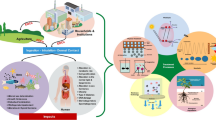Abstract
The water flea Daphnia magna (Crustacea, Cladocera) is a cyclical parthenogen, which can reproduce both by parthenogenesis and by sexual reproduction. With its ease of handling in the laboratory, several testing methods using D. magna exist for regulatory toxicity testing. Recently, several studies revealed that one of the major hormone groups in insects and crustaceans, juvenile hormones, are involved in the shift of reproductive mode from parthenogenesis to sexual reproduction (production of male neonates). Using offspring sex ratio as a new endpoint has made it possible to identify chemicals with juvenile hormone-like effects on crustaceans. The testing method using D. magna, in which offspring sex ratio is incorporated as a new endpoint, is now being proposed to the OECD as an enhanced version of the existing OECD Test Guideline 211: Daphnia magna reproduction test. No other clear-cut endpoint for identifying juvenile-hormone disrupting effects has ever been found in crustaceans than the induction of male neonates production in cladocerans. In this regard, it is expected that testing methods using D. magna are suitable for screening and risk assessment of chemicals with juvenile-hormone disrupting effects.






Similar content being viewed by others
References
ASTM (1988) Standard guide for conducting acute toxicity tests with fishes, macroinvertebrates, and amphibians. E729-88a. American Society for Testing and Materials, Philadelphia, 20 pp
ASTM (2004) Standard guide for conducting Daphnia magna life-cycle toxicity tests. E 1693–97 (reapproved 2004). American Society for Testing and Materials, West Conshohocken
Baldwin WS, Bailey R, Long KE, Klaine S (2001) Incomplete ecdysis is an indicator of ecdysteroid exposure in Daphnia magna. Environ Toxicol Chem 20:1564–1569
Dodson SI, Hanazato T (1995) Commentary on effects of anthropogenic and natural organic chemicals on development, swimming behavior, and reproduction of Daphnia, a key member of aquatic ecosystems. Environ Health Perspect 103(Suppl 4):7–11
Environment Canada (1992) Test of reproduction and survival using the cladoceran Ceriodaphnia dubia. Report EPS 1/RM/21 Feb
Hebert PDN (1987) Genotypic characteristics of cyclic parthenogens and their obligately asexual derivatives. In: Stearns SC (ed) The evolution of sex and its consequences. Birkhauser Verlag AG, Basel, 403 pp
Hobaek A, Larsson P (1990) Sex determination in Daphnia magna. Ecology 71:2255–2268
Hutchinson TH, Pounds NA, Hampel M, Williams T (1999) Life-cycle studies with marine copepods (Tisbe battagliai) exposed to 20-hydroxyecdysone and diethylstilbestrol. Environ Toxicol Chem 18:2914–2920
Kleiven OT, Larsson P, Hobaek A (1992) Sexual reproduction in Daphnia magna requires three stimuli. Oikos 65:197–206
Kusk OK, Wollenberger L (2006) Towards an internationally harmonised test method for reproductive and developmental effects of endocrine disrupters in marine copepods. Ecotoxicology, DOI: 10.1007/s10646-006-0112-2
LeBlanc GA (2006) Crustacean endocrine toxicology: a review. Ecotoxicology, DOI: 10.1007/s10646-006-0115-z
Ministry of the Environment in Japan (2004) Endocrine disrupting effects of substances. http://www.env.go.jp/en/topic/edcs.html. Accessed on January 25, 2006
Mu X, LeBlanc GA (2002a) Environmental antiecdysteroids alter embryo development in the crustacean Daphnia magna. J Exp Zool 292:287–292
Mu X, LeBlanc GA (2002b) Developmental toxicity of testosterone in the crustacean Daphnia magna involves anti-ecdysteroidal activity. Gen Comp Endocrinol 129:127–133
National Institute of Technology and Evaluation in Japan (2004) The amended chemical substances control law. http://www.safe.nite.go.jp/english/kasin.html. Accessed on January 25, 2006
Oda S, Tatarazako N, Watanabe H, Morita M, Iguchi T (2005a) Production of male neonates in four cladoceran species exposed to a juvenile hormone analog, fenoxycarb. Chemosphere 60:74–78
Oda S, Tatarazako N, Watanabe H, Morita M, Iguchi T (2005b) Production of male neonates in Daphnia magna (Cladocera, Crustacea) exposed to juvenile hormones and their analogs. Chemosphere 61:1168–1174
Oda S, Tatarazako N, Watanabe H, Morita M, Iguchi T (2006) Genetic differences in the production of male neonates in Daphnia magna exposed to juvenile hormone analogs. Chemosphere 63:1477–1484
OECD (1984) Daphnia sp. acute immobilisation test and reproduction test. OECD guidelines for testing of chemicals, 202. OECD, Paris
OECD (1998) Daphnia magna reproduction test. OECD guidelines for testing of chemicals, 211. OECD, Paris
Olmstead AW, LeBlanc GA (2002) Juvenoid hormone methyl farnesoate is a sex determinant in the crustacean Daphnia magna. J Exp Zool 293:736–739
Olmstead AW, LeBlanc GA (2003) Insecticidal juvenile hormone analogs stimulate the production of male offspring in the crustacean Daphnia magna. Environ Health Perspect 111:919–924
Seki M, Yokota H, Maeda M, Tadokoro H, Kobayashi K (2003) Effects of 4-nonylphenol and 4-tert-octylphenol on sex differentiation and vitellogenin induction in medaka (Oryzias latipes). Environ Toxicol Chem 22:1507–1516
Sohoni P, Tyler CR, Hurd K, Caunter J, Hetheridge M, Williams T, Woods C, Evans M, Toy R, Gargas M, Sumpter JP (2001) Reproductive effects of long-term exposure to bisphenol A in the fathead minnow (Pimephales promelas). Environ Sci Technol 15:2917–2925
Tabata A, Miyamoto N, Ohnishi Y, Itoh M, Yamada T, Kamei T, Magara Y (2003) The effect of chlorination of estrogenic chemicals on the level of serum vitellogenin of Japanese medaka (Oryzias latipes). Water Sci Technol 47:51–57
Tatarazako N, Oda S, Watanabe H, Morita M, Iguchi T (2003) Juvenile hormone agonists affect the occurrence of male Daphnia. Chemosphere 53:827–833
Tatarazako N, Oda S, Abe R, Morita M, Iguchi T (2004) Development of a screening method for endocrine disruptors in crustaceans using Daphnia magna (Cladocera, Crustacea). Environ Sci 17:439–449 (in Japanese with English abstract)
USEPA (2002) Short-term methods for estimating the chronic toxicity of effluents and receiving waters to freshwater organisms, 4th ed. U.S. Environmental Protection Agency Office of Water, Washington. EPA-821-R-02-013
Verslycke T, Ghekiere A, Raimondo S, Janssen CR (2006) Mysid crustaceans as standard models for the screening and testing of endocrine-disrupting chemicals. Ecotoxicology, DOI: 10.1007/s10646-006-0122-0
Yokota H, Seki M, Oshima Y, Tadokoro H, Honjo T, Kobayashi K (2001) Life-cycle toxicity of 4-nonylphenol to medaka (Oryzias latipes). Environ Toxicol Chem 20:2552–2560
Author information
Authors and Affiliations
Corresponding author
Rights and permissions
About this article
Cite this article
Tatarazako, N., Oda, S. The water flea Daphnia magna (Crustacea, Cladocera) as a test species for screening and evaluation of chemicals with endocrine disrupting effects on crustaceans. Ecotoxicology 16, 197–203 (2007). https://doi.org/10.1007/s10646-006-0120-2
Published:
Issue Date:
DOI: https://doi.org/10.1007/s10646-006-0120-2




